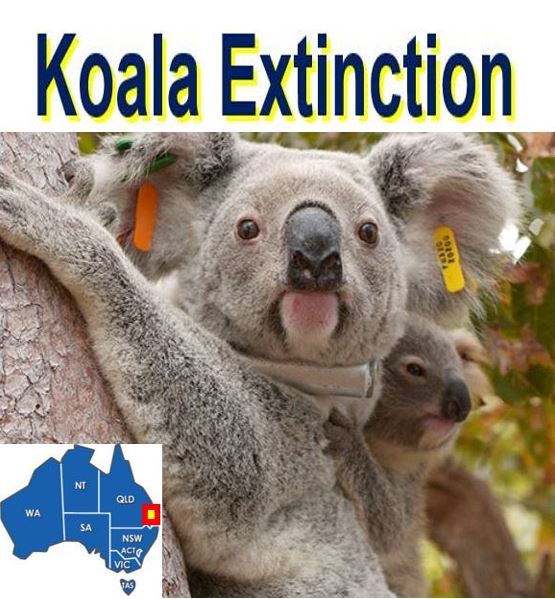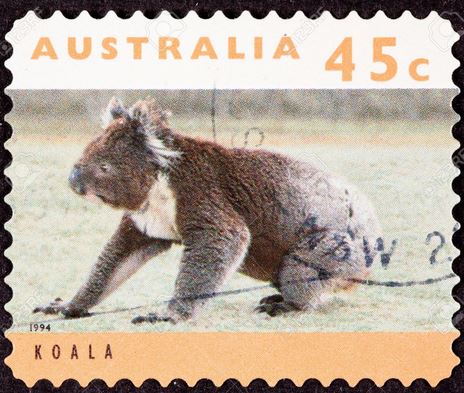The koala is at serious risk of extinction in the wild in south east Queensland without human help, specifically unless urban development in key habitats are scaled back or adapted to their lifestyles, a scientist warns.
Steven Miles, Queensland’s Environment Minister, said yesterday that an expert panel will be appointed over the next few weeks to devise ways to protect koalas that live in areas around and in Brisbane.
According to the Queensland Government’s Department of Environment and Heritage Protection:
“The group will be made up of members with diverse areas of expertise in koala conservation, including genetics, captive breeding, disease, ecology and planning.”
 Experts say that wild koalas will become extinct in south east Queensland (red square in map) within just a few generations unless urgent measures are implemented now. (Image: adapted from uq.edu.au)
Experts say that wild koalas will become extinct in south east Queensland (red square in map) within just a few generations unless urgent measures are implemented now. (Image: adapted from uq.edu.au)
Government response slow many claim
The announcement comes nearly nine months after a University of Queensland Report (citation below) warned that wild koalas would probably go extinct in much of the region ‘within a small number of generations’.
Dr. Miles, who says he did not receive a copy of the report until four months after it was published (December 2015), claims to have been meeting with all relevant stakeholders, and rejects comments that he did not go far enough in combating the koala crisis.
Dr. Miles said:
“We do need action but what we don’t need is knee-jerk action. The last we want to do is act too quickly and implement actions that aren’t backed by the science.”
Report lead author, Associate Professor Jonathan Rhodes, a member of the Landscape Ecology and Conservation Group and the Environmental Decisions Group at The University of Queensland, said:
“Urgent action is needed. At the same time we need to consider what the options are, but we can’t just leave it for years. We need to act relatively quickly and decisively.”
 Koalas spend most of their time in trees, however, they travel between trees on the ground, where they are vulnerable to dog attacks and being hit by vehicles. Prof. Rhodes said: “We need smarter and more cost-effective ways to protect koalas while our cities continue to grow.” (Image: uq.edu.au)
Koalas spend most of their time in trees, however, they travel between trees on the ground, where they are vulnerable to dog attacks and being hit by vehicles. Prof. Rhodes said: “We need smarter and more cost-effective ways to protect koalas while our cities continue to grow.” (Image: uq.edu.au)
The South East Queensland Population Report
The report found evidence of rapid koala population declines in several parts of Queensland between 1996 and 2014, especially in the Koala Coast and Pine Rivers regions, with estimated declines of 80.3% and 54.3% respectively.
There was also evidence that since 1996, the koala population has been declining at an accelerated rate.
The authors made the following recommendations:
– Use the estimated spacial distributions of koala density and measures of uncertainty to decide where future surveys should occur to maximize the effectiveness of the monitoring program.
– Design future survey locations with clear monitoring objectives in mind.
– Design survey methods explicitly to address and estimate observation error better.
– Adopt a formal database structure to make sure that data is recorded accurately and in a consistent manner, and ‘that no important data are missing from survey records.’
 The Koala has appeared on Australian postage stamps ever since the postal began. It is Queensland’s faunal emblem and one of the world’s most iconic mammals. (Image: 123rf.com)
The Koala has appeared on Australian postage stamps ever since the postal began. It is Queensland’s faunal emblem and one of the world’s most iconic mammals. (Image: 123rf.com)
Koalas ultra-vulnerable on the ground
The authors pointed out that koalas move across the ground, rather than from tree-to-tree through the canopy, to forage, find mates or seek out new habitats outside their home range.
However, it is on the ground that they are most at risk of mortality from threats of vehicle collisions and dog attacks.
The authors wrote:
“Therefore, habitat loss and fragmentation may have the combined effect of reducing the amount of habitat, but also increasing the amount of time koalas must spend moving on the ground at risk from a range of threats.”
“Therefore, the structure and permeability of the landscape appears to be an important driver of koala occurrence and movement.”
Citation: “South East Queensland Koala Population Modelling Study,” A/Prof Jonathan Rhodes, Dr. Hawthorne Beyer, Dr. Harriet Preece and Prof. Clive McAlpine. University of Queensland (UniQuest), Brisbane, Australia. August 2015.
